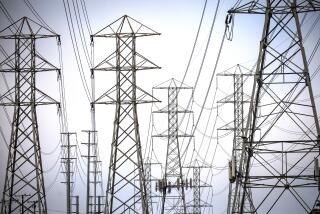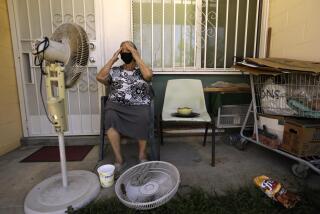Heat Strokes
- Share via
We know it’s spring, but what a wacky season it’s been so far. And there could be a few more chilly nights to come. Here are some easy-to-do and inexpensive ways you can make your home more comfortable and keep your heating bills under control.
These energy-saving ideas aren’t complicated. Many take little time and don’t even require the purchase of materials, only changing a habit or two. Others can be done for as little as $10.
Also, the 36-page “Energy Savers” is available free from the U.S. Department of Energy. It features more than 100 easy and practical energy-saving tips. Get the booklet by calling (800) 363-3732, or point your browser to https://www.eren.doe.gov.
Adjust Water Heater
Lower the water heater temperature from 140 degrees to 120 degrees.
Take showers, not baths. According to the Department of Energy, the average bath consumes up to 25 gallons of hot water; a five-minute shower uses up much less--only about 10 gallons.
Equipping your shower stalls with low-flow shower heads ($10) also dramatically reduces the consumption of water, both hot and cold.
Rapid Cycling
Rapid cycling--when a heating system fires on and off--wastes money. It occurs because of a heat-anticipation feature on thermostats that maintains a near-constant room temperature. Most electronic setback thermostats are programmed to act when they sense a 1- to 1 1/2-degree drop.
If the thermostat is misprogrammed to less than 1 degree, the heater may go into rapid cycle, firing every three minutes or less to maintain temperature. To stop rapid cycling, make sure the “cycle-rate adjustment” in the thermostat setup mode reads from 1 degree to 1 1/2 degree. If you change it, move it higher.
On most mechanical thermostats, the amperage scale is set from 0.1 to 1.2 amps. To defeat rapid cycling, set the arrow one notch higher. Let it cycle for 24 hours before adjusting it again.
Lower Thermostat
Each degree you lower the thermostat on your heating system decreases your fuel bill 3%. Going from 72 degrees down to 68 degrees doesn’t matter much in terms of comfort, but it can save up to 12% on your heating bill.
If you’re using a coil-type thermostat, you’ll get more accurate readings if you clean it. Pop off the thermostat cover and blow or gently swipe away the dust.
Programmable Thermostat
A programmable thermostat allows you to preset temperatures for different times of the day because you don’t need to keep your home at 68 degrees around the clock. Although one shouldn’t be used with heat pumps, a programmable thermostat is a real money-saver with air-conditioning too.
Choose a setting on the low end when you’re sleeping or are away and go with a higher setting at other times for savings of between 10% and 20% of your bill. Some units can store up to four temperature settings each day--morning, day, evening, night. All have a manual override switch.
Three models from Hunter Fan are typical. The Set & Save 100 ($30) lets you program one five-day stretch and a two-day period. With the Set & Save 250 ($40), you program one five-day stretch and two other separate days. The Set & Save 350 ($55) provides the most flexibility, with individual programs for all seven days. The units use AA batteries to maintain the display if the power goes off and to hold settings.
You can easily install a thermostat yourself. Always follow manufacturer’s instructions, but typically you remove the old thermostat and unscrew the wire leads attached to the terminals on the back. Reattach those wires to the new thermostat’s terminals, after inserting mounting screws in the wall, if necessary. (If you have separate heating and A/C units that use the same thermostat, you may find four leads, two for each unit.)
Typical settings for programmable thermostats:
For Heat
6 a.m. to 9 a.m.: 68 degrees
9 a.m. to 5:30 p.m.: 60 degrees
5:30 to 11 p.m.: 68 degrees
11 p.m. to 6 a.m.: 60 degrees
For Air-Conditioning
6 a.m. to 9 a.m.: 75 degrees
9 a.m. to 5:30 p.m.: 80 degrees
5:30 p.m. to 11 p.m.: 75 degrees
11 p.m. to 6 a.m.: 80 degrees
Furnace Filter
If you have a forced-air system, changing the furnace filter can save energy (up to 5%) and keep dust down in the house. The system will last longer and be less likely to break down. The most popular 16-by-20-inch duct filter costs around 50 cents when bought by the box. Change them monthly during heating season.
Measure your air filter before shopping; they come in various sizes.
An alternative to swapping out the replacement filter is to use washable filters (around $20 each). With care, they can last five years.
Fireplace Damper
An open fireplace damper lets the same amount of heated air escape up the chimney as a wide-open 48-inch window lets out. Make sure your flue is closed when you don’t have a fire going.
Reduce the number of times you use your fireplace. A roaring fire exhausts over 20,000 cubic feet of heated air per hour to the outside. Sure it feels warm by the fire, but every BTU that goes up the chimney is replaced by cold air pulled into the house elsewhere. And all that cold air has to be heated, a costly prospect.
Can’t resist a fire every few nights? Install a set of glass fireplace doors ($400 to $600). Closing these doors when you go to bed prevents large volumes of heated air in the living space from escaping after the fire has gone out.
Ceiling Fans
Ceiling fans are everywhere in warm-weather climates. Spinning counterclockwise, they move air around the room. Not all energy experts think it’s a good idea to use them in cool weather (doubters says they cool the air too much), but the fans do help bring heated air down to earth in rooms with cathedral or high-sloped ceilings.
That’s only if you slide the reversing switch on the side of the motor housing to the winter (clockwise) position. Then run the fan at its lowest speed. If you can’t reverse the blade rotation or if you think the fan is cooling off the room too much, leave it off.
Move Furniture
Move furniture away from vents, registers and radiators. This sounds simple, but many times a couch, chair or bed moved during the summer stays there, blocking the flow of heat.
With a forced-air system, blocking a supply or return vent can cause a house-wide pressure imbalance that disrupts the heat flow in the whole system.
Close the Door
Light a match and the rising hot air will draw nearby cooler air into the match flame. Heat a building, and the rising hot air will pull cold air from outside into the house.
It’s a physical principle called “stack effect.” To defeat it, cut down on spaces cold air can enter your house, such as under a door to the outside. Seal this gap with a “door snake,” a long thin cloth sack, like a beanbag. Fill it with dried peas or rice, something to make it heavy enough to stay in place. One can be made using scrap fabrics.
You can also keep the heat where it’s needed by making sure some interior doors, such as those leading to hallways or near stairways, are kept shut. This closes off natural air passageways so they can’t act as chimneys, allowing warm air to escape up through the house.
Door Sweep
If you feel cold air seeping beneath a door leading outside and find that using a door snake is inconvenient, install a draft-defeating nylon door sweep. This long, thin broomlike vinyl-and-pile attachment goes along the inside bottom edge of the door. Cut the sweep to fit with a hacksaw and keep it in place with four or five wood screws.
If you heat the garage, check to see if cold air is infiltrating along the bottom edge of the door. Rubber garage-door gaskets, nailed in place with 1-inch galvanized roofing nails, can stop that cold air cold.
Quick-Seal Windows
Dead air is a very effective insulator, and you can create a pocket of it by installing clear plastic film across the inside of your windows. Available in kits that contain plastic film and double-sided tape, the plastic becomes nearly invisible when you heat it with a blow-dryer. If you find it unsightly, place the film on windows and patio doors selectively or only in unused rooms.
Measure your window before buying; kits vary in size, and they work only with wood, aluminum and vinyl-clad molding. Payback is fast on this inexpensive technique, because heat lost through windows accounts for 10% to 25% of your overall heating bill. The kit is about $15 for a patio door.
If you can rattle your windows, they’re letting a lot of heat escape around the frames. Seal the open spaces with puttylike rope caulk before shrink wrapping. Press-in-place rope caulk ($5 per window) is mess-free and easy to use, and removing it in the spring is a cinch. But be sure to do a thorough window-sealing and caulking job before the next cold season rolls around.
Work the Drapes
Got drapes or curtains that block sunlight? Open them during the day to get free solar heat--just make sure the windows are clean. Then close the curtains just before sunset.
Also, consider insulating curtains (around $100 per window). As a general rule, each square foot of window that you insulate at night saves nearly 1 1/2 cubic feet of gas a year, which means that insulating curtains pay for themselves in around seven years, to say nothing of the added comfort.
Reprinted from the pages of Today’s Homeowner magazine. To receive more expert advice on improving your home, call (800) 456-6369 or visit the Web site at https://www.todayshomeowner.com


